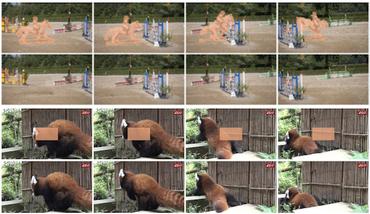Video Inpainting
43 papers with code • 4 benchmarks • 12 datasets
The goal of Video Inpainting is to fill in missing regions of a given video sequence with contents that are both spatially and temporally coherent. Video Inpainting, also known as video completion, has many real-world applications such as undesired object removal and video restoration.
Datasets
Most implemented papers
Beyond the Field-of-View: Enhancing Scene Visibility and Perception with Clip-Recurrent Transformer
In this paper, we propose the concept of online video inpainting for autonomous vehicles to expand the field of view, thereby enhancing scene visibility, perception, and system safety.
Free-form Video Inpainting with 3D Gated Convolution and Temporal PatchGAN
Free-form video inpainting is a very challenging task that could be widely used for video editing such as text removal.
Deep Video Inpainting
Video inpainting aims to fill spatio-temporal holes with plausible content in a video.
Deep Flow-Guided Video Inpainting
Then the synthesized flow field is used to guide the propagation of pixels to fill up the missing regions in the video.
Learnable Gated Temporal Shift Module for Deep Video Inpainting
How to efficiently utilize temporal information to recover videos in a consistent way is the main issue for video inpainting problems.
DVI: Depth Guided Video Inpainting for Autonomous Driving
To get clear street-view and photo-realistic simulation in autonomous driving, we present an automatic video inpainting algorithm that can remove traffic agents from videos and synthesize missing regions with the guidance of depth/point cloud.
Learning Joint Spatial-Temporal Transformations for Video Inpainting
In this paper, we propose to learn a joint Spatial-Temporal Transformer Network (STTN) for video inpainting.
Towards An End-to-End Framework for Flow-Guided Video Inpainting
Optical flow, which captures motion information across frames, is exploited in recent video inpainting methods through propagating pixels along its trajectories.
Exploiting Optical Flow Guidance for Transformer-Based Video Inpainting
Transformers have been widely used for video processing owing to the multi-head self attention (MHSA) mechanism.
Improving Video Generation for Multi-functional Applications
In this paper, we aim to improve the state-of-the-art video generative adversarial networks (GANs) with a view towards multi-functional applications.





 DAVIS
DAVIS
 YouTube-VOS 2018
YouTube-VOS 2018
 How2Sign
How2Sign
 FVI
FVI
 KITTI360-EX
KITTI360-EX
 DEVIL
DEVIL
 EgoHOS
EgoHOS
 VideoRemoval4K
VideoRemoval4K
 Apolloscape Inpainting
Apolloscape Inpainting
